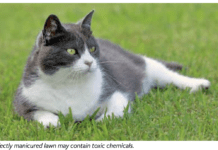

Elizabeth
Q Is it OK that we planted lilies in our garden? A friend of mine said we’re poisoning the neighborhood cats. I certainly don’t want to do that! I’ve had cats all my life and never heard of a cat poisoned by eating a lily. We’ve even had lily plants inside. My cat stays strictly indoors so I’m not worried about her in our garden, but I do see our neighbors’ cats out and about.
A Yes, certain lilies are toxic to cats. They are “nephrotoxic,” meaning ingestion of even a small amount results in kidney damage.
Signs of poisoning include:
- Uncharacteristic sluggishness
- Unsteady gait
- Drooling
- Heavy breathing
- Diarrhea
- Seizures
- Sudden bouts of vomiting
My colleagues at the Cornell Feline Health Center tell me that all plants in the genus lillium and genus hemerocallis carry the toxic principle, including common garden varieties (Stargazers, tiger lilies, peace lilies, and daylilies) and the beautiful Easter lilies that are often displayed as indoor potted plants and cut flowers during the spring holidays.
Cats can be poisoned by ingesting ANY PART of one of these lilies: leaves, stems, flowers, stamens — even the pollen is toxic.
If a cat owner discovers that their cat has ingested a lily, or had even minor exposure such as biting a leaf or getting pollen on their coat or whiskers, it is vital that they contact their veterinarian immediately. Aggressive treatment begun within 18 hours of ingestion has the best chance of preventing serious kidney damage.
© Tony Campbell | Dreamstime.com


Cat owners should avoid bringing potted lilies into the house, and should be certain to check bouquets of cut flowers carefully before display. It’s important to remember how resourceful we indoor cats can be — if we want to nibble on some fresh greens we’ll find a way to open a closed door or jump onto a supposedly inaccessible counter top to get to a plant or vase. My best advice is to strictly ban lilies from inside a cat’s house.
Outside doesn’t tend to be as big a problem, as we cats are pretty smart, but it is possible for our outdoor friends to suffer the same nephrotoxic effects after exposure to garden plants. Most reported cases of lily intoxication involve indoor cats nibbling on a plant or bouquet brought into the house (we just can’t resist a chew on a house plant).
Our Cornell friends add that tulips, foxglove, poinsettias, and philodendron are among hundreds of plants that are known to be poisonous to cats. Ingesting just a small leaf of some common ornamental plants could be enough to make a cat ill, and swallowing a sizable amount could prove fatal. You can download a PDF of poisonous plants from the Humane Society at: www.humanesociety.org/assets/pdfs/pets/poisonous_plants.pdf



